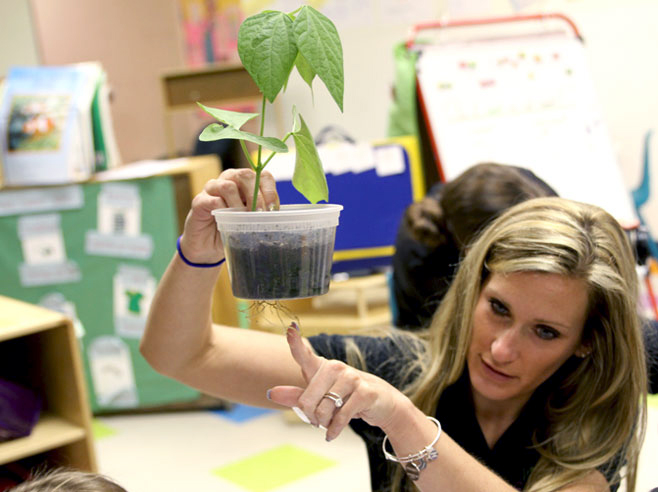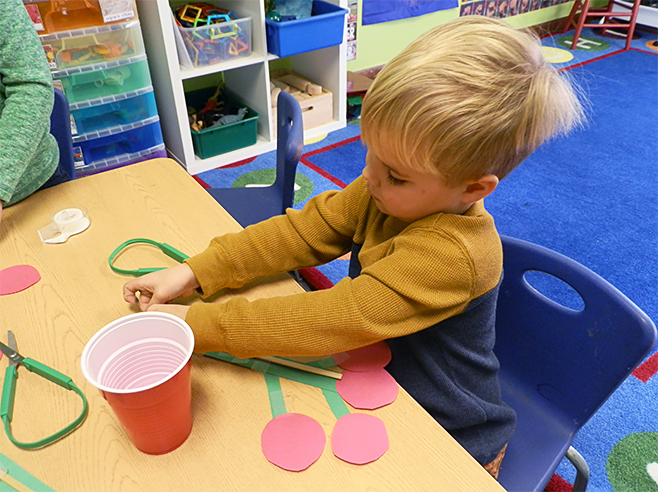Children build a model of a tomato plant, showing the parts of a plant. They design, test, and revise a support structure that will keep a model tomato plant upright.
Materials

- Circle Time: Introduction
- Plastic cups, such as 9 oz. (1 per child)
- Chart paper
- Construction paper (red for tomatoes; brown for soil)
- File folders (green for stems)
- Marker
- Masking tape
- Paper clips
- Scissors
- Plants Feed Me by Lizzy Rockwell
- Guided Small Group
- Masking tape
- Support materials, such as chopsticks, pipe cleaners, pencils, thin rope, ribbon, cardboard strips, construction or cardstock paper
- Tomato cutouts with paper clips attached
- iPad camera
- Optional: Plants Feed Me by Lizzy Rockwell
Preparation
- The engineering process extends over two parts of this activity. Plan to do the activity in different locations throughout the day.
- At Circle Time, children will EXPLORE the problem and need (how to prevent a tomato plant from flopping over).
- At Small Groups, children will PLAN, CREATE, REVISE, and SHARE their tomato support solutions.
- Preview Plants Feed Me, by Lizzy Rockwell. Make note of illustrations that show plants supported by structures. During this activity, you can show these images or you can display one or more Internet images of plant supports, such as tomato cages or stakes.
- Cut green file folders into strips: one “stem” for each child (about 12 inches x 1 inch); three to four “branches” for each child (about 5 inches x ½ inch).
- Trace three or four “tomato” circles for each child onto the red construction paper (about 2″ in diameter). Cut them out and tape a paper clip onto each circle. You might want to open the clips slightly so they will be easy to attach to the branches.
- Create a model of the tomato plant. (See Step 1 on the PDF.) Tape the branches onto the stem. Make sure the branches are not so low on the stem that they end up in the cup.
- Place the stem in the cup. Tape it to the inside of the cup.
- Do not add the tomatoes yet!
- Label each cup with a child’s name. Place all materials in the Small Group area.
- Teaching Engineering Tips Read through these tips to help support your young engineers as they become problem solvers:
- Acknowledge all ideas. Every idea is worth trying: That’s a great idea! Let’s try it!
- Allow children to fail or “get stuck.” This is when they get to figure out why their approach did not work and how they can revise it: Why do you think this structure didn’t work? What can you do to change it? Let’s test it!
- Encourage children to share and build on one another’s ideas. This helps them become communicators and collaborators in solving problems: I like how you used (child’s name)’s idea and added your own idea to it!
Directions: Lesson 6
Circle Time: Introduction
- EXPLORE. Review what children know about plants. Possible discussion ideas:
- What do plants need to grow?
- What are the different parts of a plant? Discuss how each plant part plays a role in helping the plant grow. (leaves collect sunlight, roots provide support and take in water, stems help keep it upright, fruits and flowers hold seeds for new plants)
- What would happen to a plant if the fruit or flowers were too heavy? What could we do to help the plant?
- Hold up your model and tell children it is a model of a tomato plant. Discuss why people use models of real things:
- Why would someone use a model of a tomato plant instead of a real tomato plant? Explain that models can be used to help predict or explain how real things work or are used. A model is useful when handling the real object may cause it to break. We will use a model of a tomato plant to share our ideas and help us learn about what happens to a REAL tomato plant.
- Point to the stem on the model. Talk about how the stem keeps a plant upright. Point out how the branches grow out from the stem. Let’s see what happens to the stem when we add tomatoes to the branches. Clip a few paper tomatoes to the ends of the branches. Let the stem flop over. Ask children to describe what happened to the stem when you added the tomatoes.
- Why is it important for the tomato plant to stand up tall? (so it gets sunlight; so it doesn’t block other plants from water/sunlight)
- Share illustrations in the Plants Feed Me book of plants that need support. Have children describe how the plants are supported. Use the chart paper to record children’s ideas. Revisit the ideas in Small Group time when they will build their plant supports.
- Build a model. Have children find the cup with their name on it and then build their tomato plant model.
- Have them place the stem in the cup. Mark the stem where it comes out of the cup (soil). Help children tape their branches to the part of the stem above the soil mark. Then securely tape the stem to the inside wall of the cup. You may want to suggest children crumple up brown paper to add to the cup as soil.
- Identify the problem. Once the stem is secured, have them add the tomatoes and discuss the problem. Possible discussion ideas:
- What happens when the heavy tomatoes are added to your model plant?
- Why is this bad for the plant? (stem can break; plant doesn’t get enough light)
- How can we prevent this from happening? (design a support structure)
- Draw attention to the available materials. Have children explore the support materials. Prompt them to brainstorm how they will use different materials to build a plant support.
- Children will build a support for their floppy tomato plants during Small Group time.
Guided Small Group
- CREATE Create a solution. Have children use the materials and their brainstorming ideas to design and build a plant support. If children struggle with an idea for a solution, model a solution for them.
- IMPROVE. Test the solution! Have children restate the problem. Then help them determine whether their solution solves the problem. Possible discussion ideas:
- Did your solution work to solve the problem? Why or why not?
- How did you use (material) to try and solve the problem?
- Improve it! If a design is not working and the plant is still floppy, have children revise it based on the results of the test. Possible discussion ideas:
- How do you know if your design worked?
- Why do you think the design did or did not work?
- What are some ways to make it better, if needed?
- SHARE. Document the final solution. Use the iPad camera app to take pictures of the different design solutions. Be sure to capture different solution iterations––both those that worked to support the plant and those that needed to be revised.
- Communicate. Look at pictures of two different solutions and compare them. Possible discussion ideas:
- Why did the first solution not work? What did you change to help support the tomato plant better?
- Is the final design a good support structure for the tomato plant? Why or why not?
Circle Time: Wrap-Up
- Have children compare their solutions. Place the model tomato plants where children are able to view them. Look at all the different ways we were able to support the stem and make our model tomato plants stand tall. Point out the different materials that were used in different children’s solutions. How did (child’s name) use (material) to support her model plant? How was that different from how (child’s name) used it in his model?
- Just like real engineers, we learned something today—that we can use a model to learn about real-life things and that there can be many different ways to solve one problem.


